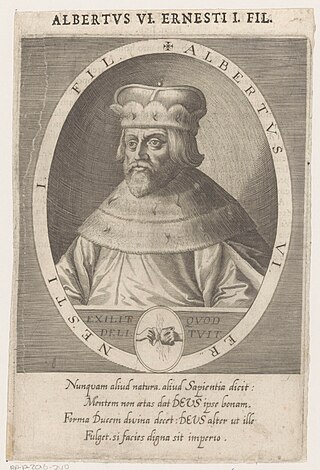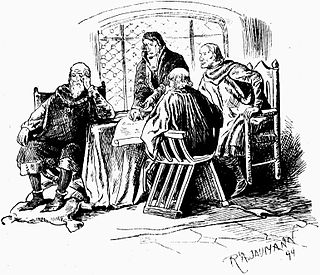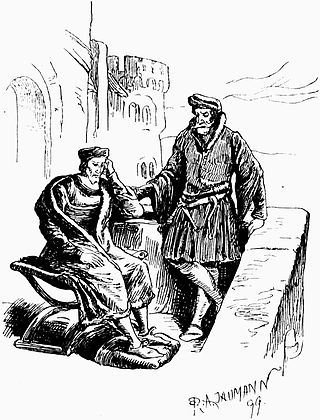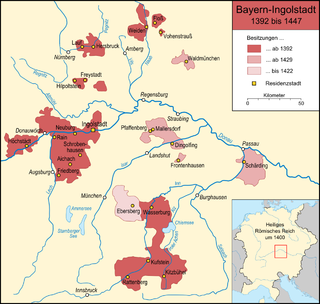
Landshut is a town in Bavaria in the south-east of Germany. Situated on the banks of the River Isar, Landshut is the capital of Lower Bavaria, one of the seven administrative regions of the Free State of Bavaria. It is also the seat of the surrounding district and has a population of more than 75,000. Landshut is the largest city in Lower Bavaria, followed by Passau and Straubing, and Eastern Bavaria's second after Regensburg.

Albert III the Pious of Bavaria-Munich, since 1438 Duke of Bavaria-Munich. He was the son of Ernest, Duke of Bavaria and Elisabetta Visconti, daughter of Bernabò Visconti.

Ernest of Bavaria-Munich, , from 1397 Duke of Bavaria-Munich.
Duke John II of Bavaria-Munich, , since 1375 Duke of Bavaria-Munich. He was the third son of Stephen II and Elizabeth of Sicily.
Frederick was Duke of Bavaria from 1375. He was the second son of Stephen II and Elizabeth of Sicily.

Louis VII, called the Bearded was the Duke of Bavaria-Ingolstadt from 1413 until 1443. He was a son of Duke Stephen III and Taddea Visconti.

Louis IX was Duke of Bavaria-Landshut from 1450. He was a son of Henry XVI the Rich and Margaret of Austria. Louis was the founder of the University of Ingolstadt.

George of Bavaria referred to as the Rich, was the last duke of Bavaria-Landshut. He was a son of Louis IX the Rich and Amalia of Saxony.

Louis X, was Duke of Bavaria (1516–1545), together with his older brother William IV, Duke of Bavaria. His parents were Albert IV and Kunigunde of Austria, a daughter of Emperor Frederick III.

William III (1375 – 12 September 1435;, was Duke of Bavaria-Munich, together and in concord with his older brother Ernest, Duke of Bavaria. William III was a son of John II and a member of the Parakeet Society.
The Parakeet Society was a union of the enemies of Louis VII the Bearded, duke of Bavaria-Ingolstadt. It was founded on April 17, 1414 by his cousin, duke Henry XVI of Bavaria-Landshut. The other members of the society were Ernest of Bavaria-Munich, his brother William III and John, Count Palatine of Neumarkt.

Bavaria-Ingolstadt was a duchy which was part of the Holy Roman Empire from 1392 to 1447.

Bavaria-Landshut was a duchy in the Holy Roman Empire from 1353 to 1503.
Maddalena Visconti was a daughter of Bernabò Visconti and his wife Beatrice Regina della Scala. Maddalena was Duchess of Bavaria-Landshut by her marriage to Frederick, Duke of Bavaria.

Catherine d'Alençon was the Duchess consort of Bavaria as the second spouse of Louis VII, Duke of Bavaria. She was a younger daughter of Peter II of Alençon and his wife Marie Chamaillart, Viscountess of Beaumont-au-Maine. Catherine was also maid of honour to Louis' sister, Isabeau of Bavaria.

Elisabeth of Bavaria-Landshut, nicknamed "Beautiful Beth", was an Electress of Brandenburg by marriage to Frederick I, Elector of Brandenburg. She acted as regent of Brandenburg during the absence of her spouse.
Margaret of Brandenburg was a Princess of Brandenburg by birth and through successive marriages Duchess of Mecklenburg, Duchess of Bavaria-Ingolstadt and Countess of Waldenfels.
The Bavarian War from 1420 to 1422, also known as the Great War of the Lords, was a conflict between Louis VII the Bearded of Bayern-Ingolstadt and Henry XVI of Bavaria-Landshut. The conflict overshadowed Louis VII's reign, which lasted more than thirty years.













